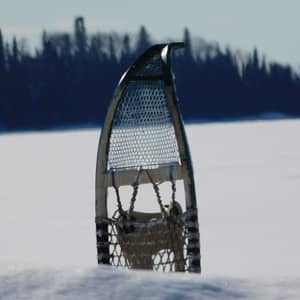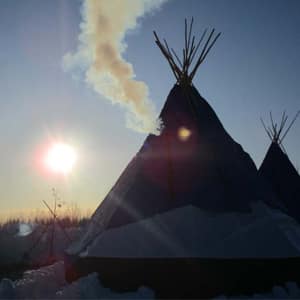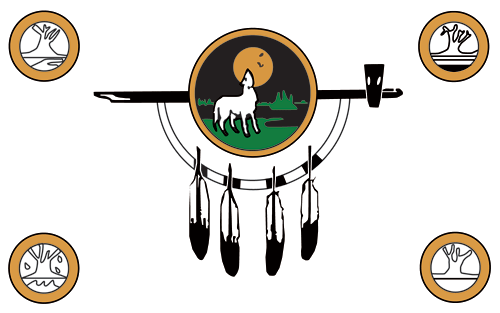Who We Are
Neskantaga First Nation is an Ojibwe community located 436 kilometers northeast of Thunder Bay, Ontario, and 180 kilometers northeast of Pickle Lake, Ontario. Travel to and from the community is possible by way of air travel, winter road, and for the more adventurous, boat and paddle. The population of Neskantaga First Nation is about 400 people of whom 300 people live on the reserve.
Once part of a major trade route, the Attawapiskat and Otoskwin rivers surrounding Neskantaga merge into a delta with significant brackish tidal marshes. History is rich in this area, with ancient Anishnawbe communities dating back to at least 3000 BC, and fur-trading sites from the early 1800s. The Neskantaga First Nation community is defined by rich culture and tradition. Closely tied to the land, many members participate in traditional harvesting of wildlife and fish, plants, bark, trees, berries and water from the cool, fresh springs located throughout the surrounding areas. The community is full of industrious people creating art, crafts and other goods. Continuing the practice of sharing oral history, many to this day share legends, and stories (such as the creation story which binds members with a shared history and purpose). Traditional healing and ceremony are actively and passively practiced through an intrinsic relationship with, and responsibility to, the land.



Mission Statement
To build a community for the membership of Neskantaga First Nation in which we may live with dignity and in harmony with each other, our land and nature; by providing leadership that will enable the membership to become self-reliant and healthy in keeping with traditional ways in partnership with others and with the guidance of the Creator in all we do.
We all be transparent and accountable by working within’ the policies and guidelines representing the best interest of Neskantaga First Nation. We will raise awareness of the factors affecting our community and will work together in the development, promotion and implementation of prevention safe and be drug and alcohol free. We will maintain a cooperative working relationship and support capacity building in the community that will promote and simulate the highest standard level of services. We will maintain the integrity of the First Nation while working within’ the values of the Seven Grandfather teachings and with the guidelines of our Creator.
Seven Grandfather Teaching
- Honesty: to be honest with yourself and others in everything you do
- Humility: to remain humble with yourself
- Truth: to learn and live the truth
- Wisdom: to have wisdom is to recognize the differences
- Love: to show unconditional love
- Respect: to respect the diversity of people’s beliefs and custom
- Bravery: to be brave in doing something right
Values Statement
Neskantaga First Nation will survive to maintain the following values as we move forward towards a proud, self-reliant First Nation Community:
- We will put the community first in all ventures, programming, initiatives and delivery of services;
- We will always respect and acknowledge the Creator;
- We will always respect the land and all it’s bounty;
- We will respect our role as caretakers of our traditional territory;
- We will strive to balance of Conservation and Resources Development in all Economic Development;
- We will respect and include our youth, women, elders in all community based ventures, programming, and initiatives
- We will respect everyone’s spirituality;
- We will honour those that have past by learning from their experiences;
- We will honour the future generations by ensuring the development of a proud and self-reliant community.
- We believe that every community member has the right to recieve services that are both responsive and timely, whether in or outside the community.
- We believe that we are accountable to the community to ensure that there continues to be adequate services available.
- We believe to be fit for duty represent the Neskantaga First Nation. Fit means being able t safety and acceptably perform all duties without the limitation due to use or after-effects relating to substance abuse
- We believe to protect the intergrity of Neskantaga First Nation at all times by being professional and ethical while representing Neskantaga First Nation.
- We believe that we have a duty and obligation to work together in the community.
- We respect and acknowledge the diversity of the community’s spiritual beliefs and faith-based practises. As a result of this diversity, we believe that we must be respectful, non-judgemental, unbiased and work without controversy.
- We believe to discourage any activity that promotes judgmental, disrespectful, prejudicial, oppressive or discriminatory practises that targets any group or individuals in the community.
- We believe to continue to attend any training that will build capacity and subsequently improve services in the community.
- We believe to treat all members and residents with respect and dignity.
- We believe to treat our elders in high esteem.
- We believe to protect our rights and the rights of others.
- We believe to maintain an environment where conflict and difference can be addressed in a manner characterized by respect and civility.
The Neskantaga First Nation Flag

“Life: Native Culture”
“IF YOU DON’T TELL YOUR CHILDREN WHO AND WHAT THEY ARE, THEY WILL NEVER KNOW. HOW CAN THEY BE PROUD OF SOMETHING THEY DON’T KNOW?”
The people of Lansdowne House for so long have expressed the determination to unify the Community with the establishment of the Relocation Project and the process of relocating the Community together with the help of Sandy Sagutch, The Chief and Council present the Community Flag, the flag represents the Native Culture, the People of the Lands.
The Native Culture is not religion. It is a way of life that you must practice daily. It is not restricted. It offers freedom of choice. You are not forced into it, yet it is made available for anyone.
- 1. Represent the four seasons: Winter, Spring, Summer, Fall.
- a) It also represents the 4 winds, or 4 directions; North, West, South, East.
- 2. The peace pipe teaches us the four laws the creator gave us.
a) Made of stone or rock, representing the mountains. The mountains teaches us something greater to ourselves, thus having faith, faith gives us power, power to help ourselves and power to help others.
b) Mad of wood, representing the trees. Trees teaches us to be honest. To be honest to ourselves.
c) Representing the glass or the tobacco we put in the peace pipe. Grass teaches us kindness, to be kind to ourselves, and to be kind to our fellow man. - – No matter what we do to the grass, we step on it, we walk and play on it, sleep on it and we burn it, it always grows back so too should be our kindess to ourselves and to others.
- – Tobacco we put in the peace pipe expresses our kindess, thanks and offering tobacco is also a sacred plant.
- d) Representing the animals, Animals teach us to have caring and sharing. Animals care for humans’ life by sharing themselves as food, clothing and other sources. So too should we care and share what we have to others and to ourselves. The sharing of the peace pipes represents all this.
3. The peace pipe also represents the sweet grass road. This road of happiness, success, and contentment.
a) This is the road of Despair, sadness, failure, discontentment and misery.
4. The four feathers.
a) Each feather represents the four cultures of life, (White, Black, Red, Yellow)
b) The feather is also the symbols of life. It has two sides so, too is our life. One side represent spiritually of the four laws. The other side represents the everyday life of shelter, clothing, work, and food.
c) The Eagle feather symbolizes our lifew, The Eagles watches over our land, our skies, and us.
5. The wolf howling at the moon.
a) The wolf howling at the moon is a remember that we must follow the four laws the Creator gave us. It reminds us to have faith, honesty, kindness, caring, and sharing.
6. Circles, long ago Indian did everything in a circle. They ate, prayed, danced, and met in a circle.
a) First circles represents us. We must start within’ ourselves.
b) Second circle represents our Family.
c) Third circle represents our community and thus expanding into the universe
Colours
White: Represents the day, snow, clean air and everything that is good.
Green: Represents the land, the Creator gave us to use and to live on it and off it.
Black: Represents the night, peace, and tranquility.
Gold: Represents the golden years we can and will have following our Native Culture.
